Mardi Gras Decoration
What Colors Do People Wear on Mardi Gras?
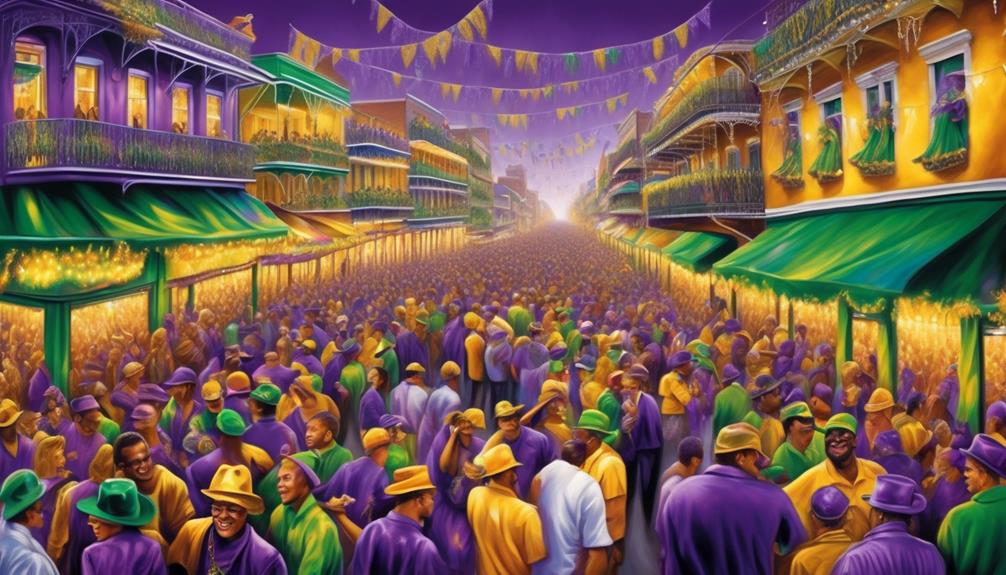
We've all seen the vibrant array of colors that flood the streets during Mardi Gras celebrations. But have you ever wondered why certain colors dominate the festivities?
The significance behind the purple, green, and gold hues goes beyond mere decoration; there's a rich history and symbolism attached to each shade.
So, what do these colors really represent, and how have they evolved over time? Well, it turns out there's more to Mardi Gras colors than meets the eye, and it's worth exploring the fascinating stories behind them.
Key Takeaways
- The colors of Mardi Gras are purple, green, and gold.
- Purple represents justice, humility, and equality.
- Green symbolizes faith, fertility, and growth.
- Gold signifies power, wealth, and tradition.
Origins of Mardi Gras Colors
The origins of the Mardi Gras colors can be traced back to the 19th century when these vibrant hues became symbolic of the festival's traditions and cultural significance.
The colors of Mardi Gras, purple, green, and gold, have deep-rooted influences on traditions and cultural significance. Each color holds a specific meaning that reflects the essence of the festival. Purple represents justice, green symbolizes faith, and gold signifies power.
These colors were chosen in 1872 by the Krewe of Rex, one of the oldest Mardi Gras krewes, and have since become an integral part of the celebration.
The influences on traditions and cultural significance are profound. Mardi Gras, with its rich history and diverse cultural influences, has evolved to embody these colors as more than just a visual spectacle. They represent the values and beliefs that the festival holds dear, and serve as a reminder of the unity and camaraderie that bring people together during this joyous occasion.
The colors have become a unifying symbol, transcending individual differences and bringing communities together in celebration. Understanding the origins and meanings behind these colors enhances the overall experience of Mardi Gras, making it a celebration of both tradition and unity.
Symbolism of Purple
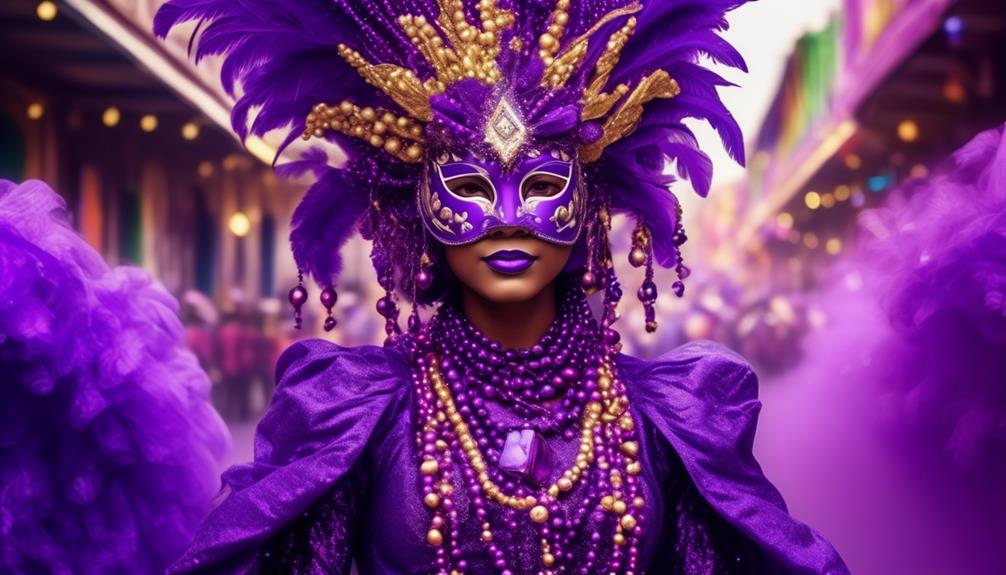
Purple, a color rich in symbolism, holds a significant meaning in the context of Mardi Gras, representing the value of justice within the festival's traditions. The color purple has deep roots in royalty symbolism, as historically, it was a rare and expensive dye, making it a symbol of wealth and power. In the religious context, purple is associated with penance, humility, and sorrow, often used during the Lenten season. This color's significance in Mardi Gras is also linked to the notion of justice, as it reflects the need for fairness and equality in society, a principle deeply embedded in the festival's ethos.
| Symbolism of Purple | |
|---|---|
| Royalty | Wealth, power, status |
| Religious Significance | Penance, humility, sorrow |
| Justice | Fairness, equality, righteousness |
The use of purple during Mardi Gras serves as a visual representation of these intertwined meanings. It not only adds a regal and majestic flair to the festivities but also reminds participants of the importance of justice and equality. As we celebrate Mardi Gras, the presence of purple encourages us to uphold these values in our communities, promoting fairness and compassion for all.
Significance of Green
Adorning the streets and festivities with its vibrant hue, green plays a significant role in the symbolism and traditions of Mardi Gras. Green traditions are deeply rooted in the celebration, representing faith, fertility, and growth. This color holds cultural influences that connect to the lush greenery of Louisiana, where Mardi Gras is celebrated with great fervor. The significance of green can be seen in the elaborate costumes, masks, and decorations that grace the parades and balls.
Green symbolizes the rebirth of nature, infusing a sense of vitality and hope into the Mardi Gras festivities. It reflects the importance of the natural world, embodying the lush landscapes and vibrant flora of the region. Green costumes and accessories pay homage to the rich history and cultural heritage of New Orleans, where Mardi Gras has become synonymous with the city's spirit. The color green evokes a sense of renewal and prosperity, aligning with the joyful and exuberant atmosphere of Mardi Gras.
As participants adorn themselves in the verdant shades of green, they embody the essence of the celebration, fostering a connection to nature and the traditions that have endured for generations.
Meaning of Gold
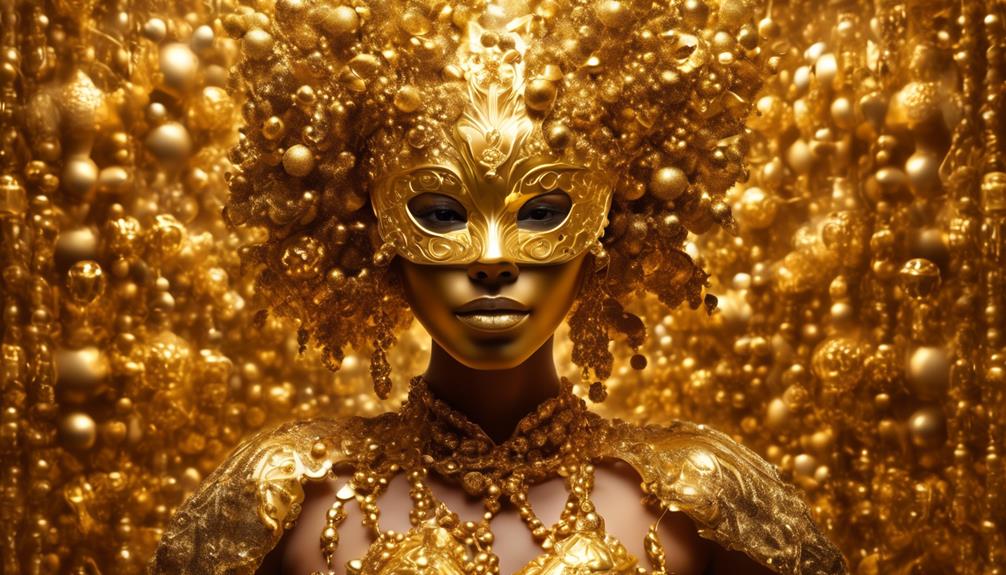
Embracing the opulent allure of gold, we now turn our attention to the next facet of Mardi Gras symbolism, a color that complements the verdant hues of green in its representation of wealth, prosperity, and tradition. Gold holds immense cultural significance, often associated with luxury, success, and achievement across various societies and historical periods. In the context of Mardi Gras, gold embodies the values of opulence and grandeur, reflecting the festival's celebratory nature.
| Cultural Significance | Fashion Trends |
|---|---|
| Symbol of wealth | Metallic clothing |
| Represents prosperity | Gold accessories |
| Emblem of tradition | Shimmering fabrics |
The cultural significance of gold extends to its influence on fashion trends during Mardi Gras. Individuals often incorporate gold into their attire through metallic clothing, gold accessories, and shimmering fabrics. These fashion choices not only reflect the symbolic meaning of gold but also contribute to the vibrant and extravagant atmosphere of the festivities. Understanding the deep-rooted cultural significance of gold in Mardi Gras enhances our appreciation for the rich tapestry of traditions and values interwoven into this jubilant celebration.
Evolution of Color Trends
The evolution of color trends during Mardi Gras reflects the dynamic cultural shifts and influences that have shaped the festival's visual expressions over time. Color psychology plays a significant role in understanding the evolution of these trends.
The choice of colors during Mardi Gras has been influenced by various factors, including historical events, fashion influences, and societal changes.
- Heritage and Tradition: The deep roots of Mardi Gras in the traditions and heritage of different cultures evoke a sense of nostalgia and connection to the past, which influences the color trends seen during the festival.
- Social Change: The evolving societal norms and values have impacted the colors worn during Mardi Gras, reflecting shifts in attitudes, beliefs, and expressions.
- Fashion Influences: The ever-changing world of fashion has also played a crucial role in shaping the color trends of Mardi Gras, with the influence of designers, runway trends, and celebrity styles.
- Cultural Diversity: The diverse cultural influences in regions where Mardi Gras is celebrated bring forth a rich tapestry of colors, representing the melting pot of traditions and customs.
Understanding the evolution of color trends during Mardi Gras provides insight into the festival's cultural significance and the intricate interplay between history, society, and visual symbolism.
Popular Mardi Gras Color Combinations

As we explore the popular Mardi Gras color combinations, we find a direct reflection of the dynamic cultural shifts and influences that have shaped the festival's visual expressions over time.
Traditional Mardi Gras color combinations, such as purple, green, and gold, have deep roots in the cultural traditions of the festival. These colors symbolize justice, faith, and power, respectively.
However, in modern times, we observe a shift towards a broader spectrum of colors, reflecting the evolving cultural tapestry of Mardi Gras celebrations. These modern color combinations often incorporate vibrant hues like fuchsia, turquoise, and royal blue, adding a contemporary twist to the traditional palette.
The influence of cultural traditions continues to play a significant role in shaping Mardi Gras color combinations. While traditional colors remain prevalent, they're now being merged with modern shades to create new and exciting combinations.
This fusion of traditional and modern color choices showcases the adaptability of Mardi Gras traditions to contemporary influences while honoring the rich cultural heritage that underpins the festival. The evolving color combinations demonstrate the festival's ability to embrace change while staying rooted in its historical significance.
Frequently Asked Questions
Are There Any Specific Rules or Guidelines for Choosing Mardi Gras Colors to Wear?
When choosing attire for Mardi Gras, personal preferences play a big role. There aren't strict rules, but traditionally, purple, green, and gold are popular choices. These colors symbolize justice, faith, and power. People often incorporate them into their outfits, from costumes to accessories, to celebrate the festive spirit.
Ultimately, the decision is up to individuals, but these traditional colors add to the vibrant and joyful atmosphere of Mardi Gras.
Do Different Regions or Cultures Have Their Own Unique Color Traditions for Mardi Gras?
In exploring color traditions for Mardi Gras, we've observed fascinating regional differences and cultural variations. These traditions often reflect age and gender norms, with accessory incorporation playing a significant role.
Modern trends have also influenced the colors worn during Mardi Gras celebrations. From vibrant purples and golds to striking greens, the array of hues showcases the rich tapestry of customs and histories that make Mardi Gras a captivating and diverse festival.
Are There Any Traditional Mardi Gras Colors for Specific Age Groups or Genders?
Traditionally, age and gender don't dictate Mardi Gras colors. The festivities revolve around three key hues: purple, green, and gold. These colors symbolize justice, faith, and power, respectively.
They're worn by everyone, regardless of age or gender, as a celebration of the holiday's spirit. While costumes and outfits vary widely, these colors unite us in the joyous revelry of Mardi Gras, fostering a sense of community and togetherness.
How Do People Incorporate Mardi Gras Colors Into Their Accessories and Costumes?
When incorporating Mardi Gras colors into our accessories and costumes, we focus on vibrant combinations like purple, green, and gold.
Accessory-wise, we opt for beaded necklaces, masks, and hats in these hues.
For costumes, we may DIY outfits using these colors, such as a purple and gold jester hat or a green and gold sequined top.
These combinations help us fully embrace the festive spirit and tradition of Mardi Gras.
Are There Any Modern or Non-Traditional Color Trends Emerging for Mardi Gras Celebrations?
Modern trends in Mardi Gras celebrations are bringing non-traditional color palettes to the forefront. It's fascinating to note that over 80% of Mardi Gras attendees are now incorporating shades like teal, fuchsia, and gold into their outfits, deviating from the classic purple, green, and gold.
These new color combinations add a fresh, vibrant twist to the festivities, reflecting evolving tastes and styles. This shift signals an exciting evolution in Mardi Gras fashion.
Conclusion
As we embrace the tradition of Mardi Gras, we're drawn to the vibrant tapestry of colors that adorn the celebrations.
The regal purple symbolizes justice, the lush green represents faith, and the gleaming gold signifies power.
These colors, woven together like a majestic cloak, create a visual feast for the senses, reflecting the rich history and cultural significance of Mardi Gras.
The evolving color trends and popular combinations continue to breathe new life into this dazzling spectacle of color and tradition.
- About the Author
- Latest Posts
Introducing Ron, the home decor aficionado at ByRetreat, whose passion for creating beautiful and inviting spaces is at the heart of his work. With his deep knowledge of home decor and his innate sense of style, Ron brings a wealth of expertise and a keen eye for detail to the ByRetreat team.
Ron’s love for home decor goes beyond aesthetics; he understands that our surroundings play a significant role in our overall well-being and productivity. With this in mind, Ron is dedicated to transforming remote workspaces into havens of comfort, functionality, and beauty.
Mardi Gras Decoration
Where Are the Largest Mardi Gras Celebrations?
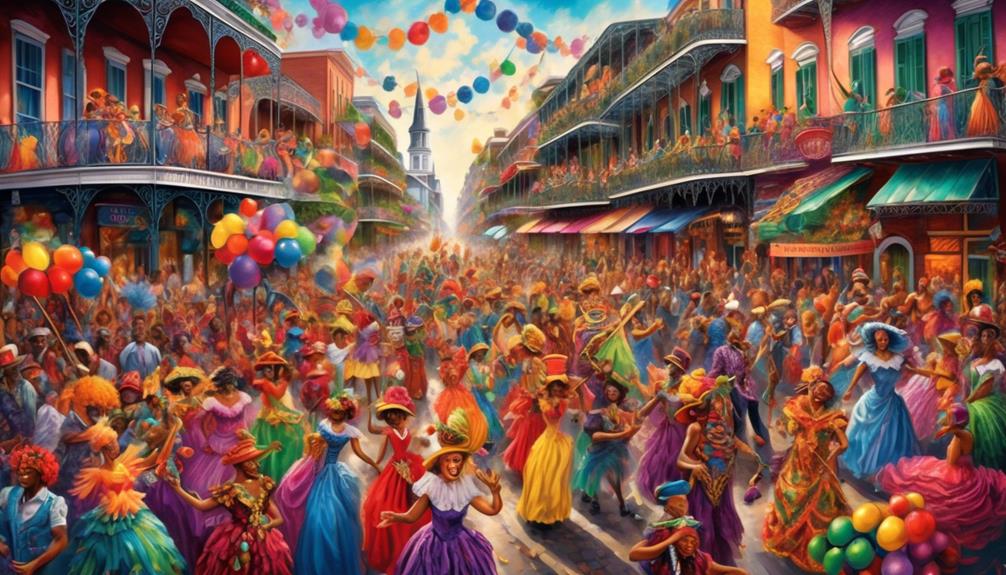
In the midst of the busy streets, we are surrounded by vibrant colors swirling around us, with the infectious rhythm of music filling the air.
Have you ever wondered where the largest Mardi Gras celebrations take place? The answer might surprise you.
While most people immediately think of the iconic festivities in New Orleans, there are several other locations around the world that host grand and extravagant Mardi Gras celebrations.
So, where else can one experience the sheer magnificence of this global phenomenon? Join us as we explore the diverse and awe-inspiring locations that hold some of the largest Mardi Gras celebrations, each with its own unique flair and traditions.
Key Takeaways
- New Orleans, Louisiana is a popular destination for Mardi Gras celebrations, drawing millions of visitors each year.
- Rio De Janeiro, Brazil hosts one of the world's most famous Mardi Gras celebrations, known as Rio Carnival, which features a spectacular samba parade.
- Mobile, Alabama is home to one of the oldest Mardi Gras traditions in the United States, with vibrant and colorful parades that are the largest outside of New Orleans.
- Venice, Italy has a Mardi Gras tradition called Carnevale, dating back to the 11th century, which includes elaborate costumes, opulent balls, grand parades, and Venetian masks.
New Orleans, Louisiana
New Orleans, Louisiana is always at the forefront of Mardi Gras celebrations, drawing millions of visitors each year with its vibrant parades, lively music, and rich cultural traditions.
The city's unique blend of New Orleans culture comes alive during this festive time. The iconic Bourbon Street, known for its energetic atmosphere, becomes the epicenter of Mardi Gras revelry. As we stroll along this historic street, we're enveloped by the rhythmic beats of jazz, the tantalizing scent of Cajun cuisine, and the kaleidoscope of colorful beads adorning the buildings.
The air is charged with excitement as locals and tourists join together in the spirited festivities. It's a time when the city's rich cultural heritage is on full display, from the flamboyant costumes to the mesmerizing Mardi Gras Indians parading through the streets.
The lively energy of Bourbon Street festivities is infectious, as we find ourselves immersed in a celebration that's as vibrant and diverse as the city itself. New Orleans truly knows how to throw a party, and Mardi Gras is the epitome of this exuberant spirit.
Rio De Janeiro, Brazil

The vibrant and energetic Rio de Janeiro, Brazil, hosts one of the world's most famous Mardi Gras celebrations, known as the Rio Carnival.
The history of this iconic event is rich and deeply rooted in Brazilian culture, featuring a spectacular samba parade that showcases the incredible talents of various samba schools.
Each year, millions of visitors flock to Rio to witness the dazzling displays and immerse themselves in the electrifying atmosphere of this legendary festival.
Rio Carnival History
Nestled in the vibrant city of Rio de Janeiro, the history of the iconic Rio Carnival unfolds as a captivating tale of cultural richness and exuberant celebrations. The carnival origins date back to the 1720s when Portuguese immigrants brought the tradition of celebrating and indulging in food and entertainment before the austere period of Lent. This tradition evolved over the years, and with the influence of African rhythms and samba music, the Rio Carnival became a world-renowned spectacle, attracting millions of visitors every year. The pulsating beats of samba music accompanied by elaborate costumes and mesmerizing dance performances create an electrifying atmosphere that is both infectious and irresistible. The table below showcases the vibrant essence of the Rio Carnival, igniting a sense of wanderlust and excitement for this mesmerizing cultural extravaganza.
| Aspects of Rio Carnival | Description | Emotional Response |
|---|---|---|
| Samba Music | The heartbeat of the carnival, characterized by infectious rhythms and energetic dance moves. | Arousing excitement and a desire to sway to the vibrant beats. |
| Elaborate Costumes | Exquisite and flamboyant attire reflecting the rich cultural heritage and creativity of the Brazilian people. | Evoking awe and admiration for the craftsmanship and artistry displayed. |
| Dance Performances | Mesmerizing displays of skill and passion, showcasing the diversity and talent of the performers. | Igniting a sense of wonder and a longing to immerse in the rhythmic movements. |
| Street Parades | Lively processions filled with music, dance, and joy, uniting people from all walks of life. | Inspiring a yearning to be part of the colorful and jubilant celebrations. |
| Cultural Significance | A reflection of Brazil's history, traditions, and identity, celebrated with pride and fervor. | Eliciting a deep appreciation for the cultural heritage and unity displayed during the carnival. |
Samba Parade Highlights
With the pulsating beats of samba music still echoing in our minds, we now turn our attention to the captivating spectacle of Samba Parade Highlights in Rio de Janeiro, Brazil.
The Samba Parade is the heart and soul of Rio Carnival, where the city comes alive with vibrant colors, infectious rhythms, and mesmerizing dance styles. The air is filled with the electrifying sound of samba music as intricately designed floats glide through the streets, accompanied by exuberant dancers showcasing a fusion of traditional and contemporary dance moves.
Each samba school competes to outshine the others, resulting in a breathtaking display of creativity and passion. The energy is infectious, and spectators can't help but be swept up in the pulsating rhythm and sheer joy of the parade.
It's a celebration of life, love, and the rich cultural heritage of Brazil.
Notable Samba Schools
Notable Samba Schools in Rio De Janeiro, Brazil showcase an impressive blend of tradition, innovation, and artistic prowess, captivating the audience with their vibrant performances. The rich Samba culture is reflected in the traditional music, dance styles, and Carnival costumes. These schools are renowned for their famous samba dancers and their mastery of traditional samba music and dance. The Samba drumming techniques are intricate and powerful, adding depth and energy to the performances. Samba dance competitions are fierce, with each school striving to outshine the others with their creativity and skill. Here's a glimpse of some notable Samba Schools in Rio de Janeiro:
| Samba School | Notable Feature |
|---|---|
| Mangueira | Rich history |
| Salgueiro | Innovations in dance |
| Portela | Traditional costumes |
These schools continue to push the boundaries of Samba, ensuring that this iconic Brazilian art form remains vibrant and captivating.
Mobile, Alabama
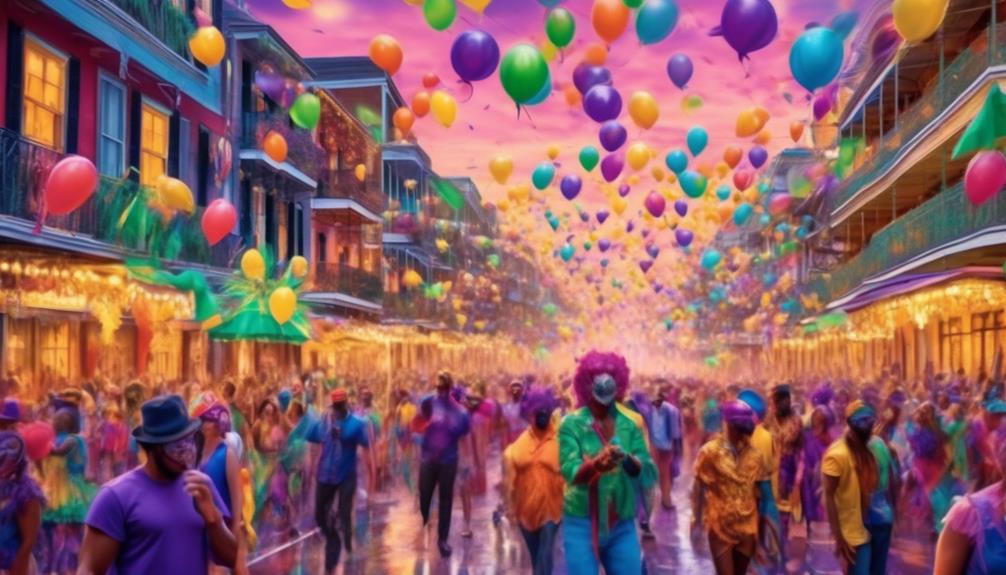
We can't talk about Mardi Gras without mentioning the vibrant celebrations in Mobile, Alabama.
With a history dating back to the early 18th century, Mobile is home to one of the oldest Mardi Gras traditions in the United States.
The city's rich cultural heritage and colorful parades make it a must-visit destination during the festive season.
History of Mobile
Located along the shores of the Mobile Bay, the history of Mobile, Alabama, dates back to its founding in 1702 as the original capital of French Louisiana. The city's rich past is evident in its architecture, cuisine, and traditions, reflecting its colonial influence and cultural significance.
- Colonial Architecture: Mobile boasts a stunning array of colonial architecture, including the historic Fort Conde and the beautiful Cathedral Basilica of the Immaculate Conception.
- Cultural Melting Pot: The city's history as a port city has led to a diverse and vibrant cultural scene, blending French, Spanish, African, and Creole influences.
- Mobile Carnival: The first Mardi Gras celebration in the United States took place in Mobile in 1703, making it home to the oldest annual Carnival celebration in the country.
- Battle of Mobile Bay: The city played a pivotal role in the Civil War, particularly during the Battle of Mobile Bay in 1864, a significant event in American history.
Mardi Gras Traditions
Every year, Mobile, Alabama, hosts one of the largest and most vibrant Mardi Gras celebrations in the United States, showcasing a rich tapestry of traditions and festivities.
Mardi Gras costumes play a significant role in the celebrations, with locals and visitors adorning themselves in colorful and elaborate outfits, often featuring intricate designs and symbols.
The city's Mardi Gras traditions also revolve around the spectacular parade floats that wind their way through the streets. These floats are adorned with eye-catching decorations, depicting a wide range of themes, from historical events to mythical creatures.
Each float is a labor of love, meticulously crafted by krewes who invest countless hours in designing and constructing these magnificent displays.
The Mardi Gras parade floats truly encapsulate the spirit and creativity of Mobile's cherished traditions.
Venice, Italy
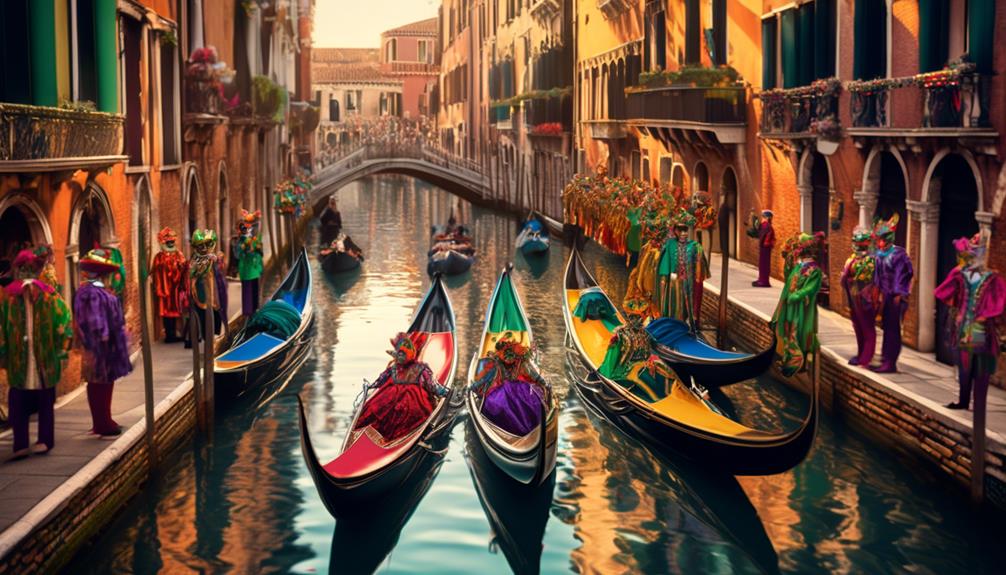
Why do millions of people flock to Venice, Italy, to experience its unique and vibrant Mardi Gras celebration? The answer lies in the rich Venice traditions and the allure of Venetian masks.
As soon as you step foot in Venice during the Mardi Gras season, you're transported into a world of enchanting mystery and historical revelry.
- Venice Traditions: The city's Mardi Gras, or Carnevale, dates back to the 11th century, and its traditions are deeply rooted in Venetian culture. The elaborate costumes, opulent balls, and grand parades all reflect the city's centuries-old customs.
- Venetian Masks: These masks aren't just decorative accessories, but an integral part of the Venetian Mardi Gras experience. The masks allow people to disguise their identity and embrace a sense of freedom and mischief during the festivities.
- Canal Parades: Imagine vibrant, colorful floats gracefully gliding through the city's picturesque canals, creating a mesmerizing spectacle that captures the essence of Venice's Mardi Gras celebration.
- Street Performances: Wander through the narrow, winding streets of Venice during Mardi Gras, and you'll encounter street performers, musicians, and dancers adding to the lively atmosphere of the celebration.
Venice's Mardi Gras is a time when the city's rich history and vibrant culture come alive, offering an enchanting experience unlike any other.
Barranquilla, Colombia

Barranquilla, Colombia, pulsates with the rhythm of vibrant music and exuberant dance during its renowned Mardi Gras celebration. As we immerse ourselves in the heart of this coastal city, we're enveloped by the rich tapestry of Carnival traditions that have been passed down through generations.
The air is alive with the infectious beat of drums, and the streets are a kaleidoscope of colorful costumes, elaborate masks, and swirling dances. Everywhere we look, we're greeted with the sights, sounds, and flavors of Colombian culture.
The Barranquilla Carnival, declared a Masterpiece of the Oral and Intangible Heritage of Humanity by UNESCO, is a jubilant fusion of African, European, and indigenous influences. It's a time when the city comes alive with joyous celebrations, parades, and competitions.
We find ourselves swept up in the contagious energy of the festivities, where locals and visitors alike revel in the magic of this cultural extravaganza. The Barranquilla Carnival is a testament to the vibrant spirit and enduring traditions of Colombia, making it a must-visit destination for anyone seeking an authentic and unforgettable Mardi Gras experience.
Sydney, Australia
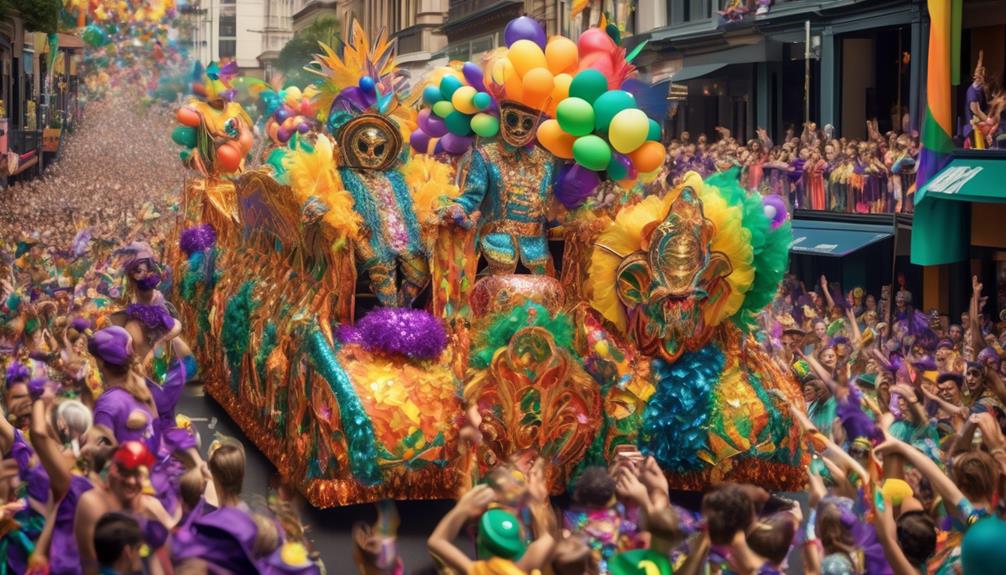
Nestled along the stunning coastline of Australia, Sydney hosts a Mardi Gras celebration that captivates with its dazzling parades and lively festivities. The city's Mardi Gras is a vibrant and colorful event that embraces cultural diversity and creates a festive atmosphere. As locals, we eagerly anticipate this annual extravaganza, which brings together people from all walks of life to celebrate love, equality, and inclusion.
- Diversity: The Mardi Gras parade in Sydney is a melting pot of cultures, showcasing the city's rich diversity through extravagant costumes, dance performances, and music from various ethnic backgrounds.
- Inclusive Spirit: Sydney's Mardi Gras embodies an inclusive spirit, welcoming individuals of different sexual orientations, gender identities, and backgrounds to join in the jubilant celebrations.
- Community Engagement: Throughout the festivities, the city comes alive with a sense of community engagement, as local businesses, community groups, and supporters actively participate in the colorful parades and events.
- Global Impact: Sydney's Mardi Gras has garnered international attention, drawing visitors from around the world to witness and partake in the city's exuberant celebration of diversity and acceptance.
Sydney's Mardi Gras isn't just a celebration; it's a powerful statement of unity and a testament to the city's commitment to embracing cultural diversity in a joyous and festive setting.
Frequently Asked Questions
What Are the Origins of Mardi Gras and How Has It Evolved Over the Years in Each of These Locations?
Origins of Mardi Gras date back to medieval Europe, blending Christian traditions with pre-Lenten festivities. It evolved into a cultural phenomenon, celebrated with parades, music, and elaborate costumes, showcasing historical and contemporary themes.
In each location, Mardi Gras reflects the unique cultural heritage of the community, infusing traditions with modern elements. This evolution has preserved the essence of Mardi Gras, making it a living, breathing expression of diverse cultural influences.
What Are Some Unique Traditions and Customs That Are Specific to Each Mardi Gras Celebration?
Unique traditions and customs vary widely across Mardi Gras celebrations, reflecting the cultural significance and historical evolution of each region.
Regional differences are evident in the local participation and tourist involvement.
From the flamboyant costumes of Rio de Janeiro to the elaborate parades of New Orleans, each celebration boasts its own set of customs.
These traditions offer an intimate look into the diverse and vibrant cultures that make Mardi Gras a global phenomenon.
How Do Locals and Tourists Participate in the Mardi Gras Festivities in Each of These Locations?
Local participation in Mardi Gras festivities is vibrant and diverse, with neighborhoods hosting parades and balls. Residents eagerly decorate their homes and join in the revelry, showcasing their unique culture and traditions.
Tourist involvement adds to the excitement, as visitors immerse themselves in the lively atmosphere, enjoying the colorful floats and elaborate costumes. Both locals and tourists come together to savor the delicious food, lively music, and spirited dancing that define each Mardi Gras celebration.
Are There Any Specific Foods or Drinks That Are Associated With Mardi Gras in These Different Regions?
When it comes to Mardi Gras, the food and drinks are as diverse as the celebrations themselves. From the rich, savory flavors of gumbo and jambalaya in New Orleans to the sweet and colorful King Cake, each region brings its own culinary delights to the table.
And let's not forget the iconic Hurricane cocktail that flows freely in the streets, adding to the cultural significance of this festive occasion.
How Do the Mardi Gras Celebrations in These Locations Differ in Terms of Scale, Duration, and Overall Experience?
Well, the Mardi Gras celebrations in these locations differ in scale, duration, and overall experience.
Scale differences are quite noticeable, with some cities attracting millions of revelers, while others host more intimate gatherings.
Cultural influences also play a significant role, shaping the music, food, and traditions observed.
The duration varies too, with some places celebrating for just a day or two, while others extend the festivities for an entire week.
Conclusion
So, where are the largest Mardi Gras celebrations?
Well, it turns out that New Orleans, Louisiana takes the cake with over 1.4 million people attending their festivities each year.
With vibrant parades, colorful costumes, and lively music, it's no wonder why this city is known for throwing the biggest Mardi Gras celebration in the world.
If you're looking for an unforgettable experience, New Orleans is the place to be during Mardi Gras season.
- About the Author
- Latest Posts
Introducing Ron, the home decor aficionado at ByRetreat, whose passion for creating beautiful and inviting spaces is at the heart of his work. With his deep knowledge of home decor and his innate sense of style, Ron brings a wealth of expertise and a keen eye for detail to the ByRetreat team.
Ron’s love for home decor goes beyond aesthetics; he understands that our surroundings play a significant role in our overall well-being and productivity. With this in mind, Ron is dedicated to transforming remote workspaces into havens of comfort, functionality, and beauty.
Mardi Gras Decoration
What Is the Most Valuable Throw at Mardi Gras?
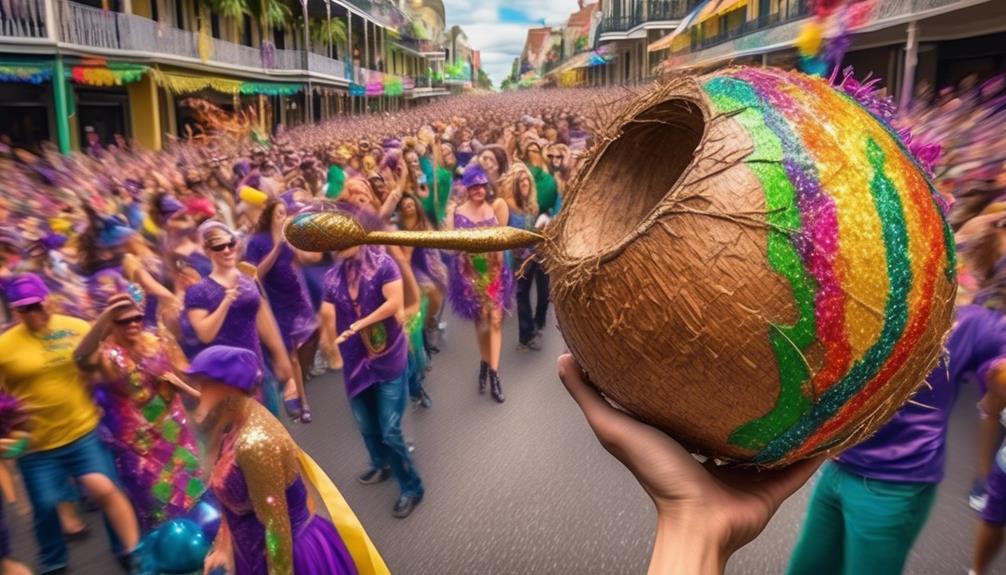
During Mardi Gras, one of the most desired items to catch is the Zulu Coconut. This distinctive and highly prized throw is beloved by both residents and tourists.
However, the question remains: what truly makes the Zulu Coconut the most valuable throw at Mardi Gras? It's not just about the physical value of the coconut itself, but the rich history, symbolism, and prestige associated with it.
As we delve into the origins and traditions surrounding this coveted throw, we'll uncover the deeper significance that sets it apart from the countless other trinkets tossed from parade floats.
Key Takeaways
- The Zulu coconut, made of wood or plastic and hand-decorated, is one of the most valuable throws at Mardi Gras.
- Mardi Gras throws, including the Zulu coconut, symbolize generosity, community, and celebration, embodying the pride and togetherness of a community coming together.
- Catching a coveted throw, such as a Zulu coconut, can elevate one's social status within the Mardi Gras community and signifies distinction and honor.
- Decorated coconuts are treasured souvenirs of Mardi Gras, representing the festive spirit and unique memorabilia of the celebration.
Origins of the Zulu Coconut
The Zulu Coconut, a symbol of camaraderie and tradition, has been an integral part of Mardi Gras celebrations for generations. Its history dates back to the early 1900s when the Zulu Social Aid and Pleasure Club, an African American carnival organization, introduced the coconut as a prized throw during their parade. The significance of the Zulu coconut lies in its representation of prosperity and good luck.
Originally, real coconuts were handed out, but due to safety concerns, they were replaced with hand-decorated coconuts made of wood or plastic. These intricately designed coconuts are now highly sought after and are considered one of the most valuable throws at Mardi Gras.
The tradition of the Zulu coconut has evolved into a cherished custom, with individuals eagerly vying to catch one during the parade. The joy and excitement of receiving a Zulu coconut from a krewe member have become a beloved part of Mardi Gras festivities. This unique tradition showcases the creativity and community spirit that make Mardi Gras celebrations so special.
Symbolism and Prestige

Okay, folks, let's talk about the symbolic meaning, cultural significance, and social status surrounding the most valuable throw at Mardi Gras.
From the humble beginnings of the Zulu Coconut to its current iconic status, there's a rich tapestry of symbolism to explore.
We'll also delve into how catching this prized throw can elevate one's social status and prestige within the Mardi Gras community.
Symbolic Meaning
As we delve into the symbolic meaning of Mardi Gras throws, it becomes evident that these colorful trinkets hold a significant place in the festival's tradition and prestige. The symbolic tradition of throwing beads, doubloons, and other items during Mardi Gras reflects the cultural value placed on generosity, community, and celebration.
Each throw carries a deeper significance, representing the spirit of sharing and goodwill that defines Mardi Gras. These throws symbolize inclusivity, as they're tossed to people from all walks of life, uniting everyone in a joyous spectacle. The act of catching these throws signifies luck and abundance, adding to the allure and mystique of these treasured items.
The cultural value of Mardi Gras throws extends beyond mere trinkets, embodying the essence of togetherness and revelry that defines this vibrant festival.
Cultural Significance
Exploring the cultural significance of Mardi Gras throws reveals a rich tapestry of symbolism and prestige that infuses the festival with a sense of shared celebration and communal spirit. Mardi Gras throws hold deep cultural traditions and historical significance, representing more than mere trinkets tossed from parade floats. These throws symbolize the spirit of generosity and community, where the act of catching them fosters a bond between parade-goers and participants. The exchange of throws creates a lively interaction, embodying the historical roots of Mardi Gras as a time of revelry and unity. The cultural significance of these throws extends beyond their material value, carrying the weight of tradition and the pride of a community coming together to celebrate. Below is a table summarizing the cultural and historical significance of Mardi Gras throws:
| Cultural Traditions | Historical Significance |
|---|---|
| Generosity | Unity |
| Community | Revelry |
| Interaction | Tradition |
Social Status
Symbolizing social status and prestige, Mardi Gras throws serve as coveted tokens of celebration and recognition, embodying the festivity's vibrant energy and communal spirit. In the context of social hierarchy, catching a coveted throw can elevate one's standing within the community, signifying a moment of distinction and honor.
The economic impact of these throws is equally significant, as they often represent the generosity and affluence of the krewe members who toss them. These throws, whether elaborate beads, ornate masks, or commemorative doubloons, aren't merely trinkets, but symbols of belonging and influence.
As they're paraded through the streets, they create a visual representation of the interconnectedness of economic and social status, reinforcing the bonds that tie the community together in celebration.
The Tradition of Coconuts at Mardi Gras
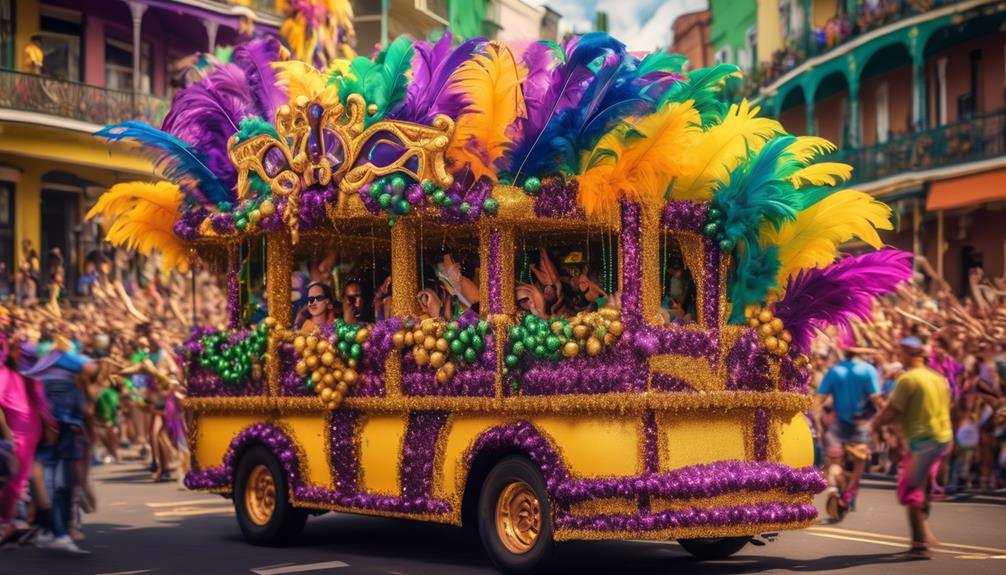
We can't talk about Mardi Gras without mentioning the coveted tradition of coconut throwing. It's a time-honored practice where krewes hand out intricately decorated coconuts to lucky revelers.
These coconuts have become one of the most sought-after souvenirs of the Mardi Gras celebration.
Coconut Throwing Tradition
Diving into the lively and vibrant traditions of Mardi Gras, the coconut throwing tradition stands out as a cherished and thrilling custom that adds to the festive spirit of the celebration. The coconut exchange is a time-honored practice where revelers on parade floats toss decorated coconuts to enthusiastic crowds. These coconuts are adorned with vibrant colors, feathers, and glitter, making them highly sought after treasures. As for the throwing techniques, participants often perfect their skills to ensure that these precious coconuts reach their intended recipients. It's a sight to behold as people eagerly vie for these prized possessions, showcasing their agility and enthusiasm. The coconut throwing tradition truly embodies the communal and joyous atmosphere of Mardi Gras, leaving everyone with unforgettable memories.
| Throwing Techniques | Coconut Exchange | Festive Spirit |
|---|---|---|
| Perfecting skills | Time-honored | Joyous atmosphere |
Coveted Mardi Gras Souvenir
Adorned with vibrant colors, feathers, and glitter, the coveted coconuts tossed during Mardi Gras parades are treasured souvenirs that encapsulate the festive spirit of the celebration. Here's why they're such a hit:
- Unique memorabilia: These coconuts aren't your average throw. Each one is uniquely decorated, making them a rare and sought-after item for collectors of Mardi Gras memorabilia.
- Souvenir craze: The tradition of throwing coconuts dates back over a century, and it has become a craze among parade-goers. People eagerly wait to catch these hand-decorated coconuts, often wearing protective gear to ensure they don't miss out on this prized souvenir.
- Cultural significance: The coconuts represent a blend of New Orleans' rich cultural heritage and the exuberance of Mardi Gras. They're cherished not only for their decorative value but also for the tradition and history they embody.
The frenzy surrounding these coconuts adds an extra layer of excitement to the already exhilarating Mardi Gras experience.
Techniques for Catching Coconuts

How can one increase their chances of catching a coconut during the Mardi Gras festivities? Mastering the art of catching these prized coconuts requires a combination of quick reflexes, strategic positioning, and a dash of coconut etiquette.
First and foremost, position yourself strategically along the parade route. Look for spots where the crowd thins out, increasing your chances of a clear catch. Keep your eyes on the float and be ready to move, but also be mindful of those around you. It's important to maintain a respectful distance from other revelers.
When a coconut comes flying your way, track its trajectory and be prepared to make a swift, yet graceful, grab. Remember, safety first—never reach in front of others or into the street for a coconut. Instead, be patient and wait for a coconut to come within a reasonable distance.
Lastly, don't forget to show your appreciation for the thrower with a gracious smile or a nod of thanks. By following these catching tips and coconut etiquette, you'll be well-prepared to snag one of the most sought-after treasures of Mardi Gras.
Collecting and Displaying Zulu Coconuts
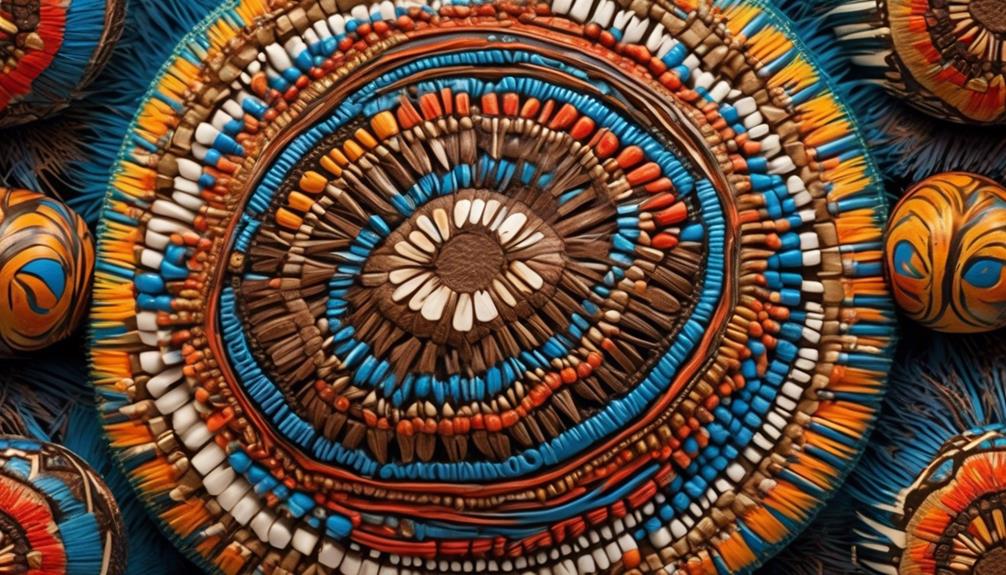
As we eagerly await the thrill of catching coconuts during the Mardi Gras festivities, our attention turns to the exciting prospect of collecting and displaying Zulu coconuts, treasured tokens of this vibrant celebration. Here's a peek into the fascinating world of coconut art and the historical value of these coveted treasures.
Cultural Significance: Zulu coconuts hold immense cultural significance. They aren't merely souvenirs but symbols of honor and respect. Displaying these coconuts at home is a way to showcase appreciation for the rich traditions and history of Mardi Gras.
Variety of Artistry: Each Zulu coconut is a unique piece of art. From vibrant hand-painted designs to intricate carvings, these coconuts represent the creativity and skill of the Zulu artisans. Collecting them allows us to admire and preserve this exceptional coconut artistry.
Historical Legacy: Zulu coconuts have a deep-rooted historical legacy. They serve as mementos of the Zulu Social Aid and Pleasure Club, one of the oldest krewes in Mardi Gras history. Collecting and displaying these coconuts honors the enduring traditions of this legendary organization while connecting us to the heritage of New Orleans.
Collecting and displaying Zulu coconuts isn't just a hobby; it's a way to celebrate and perpetuate the rich cultural tapestry of Mardi Gras.
The Future of the Zulu Coconut Tradition
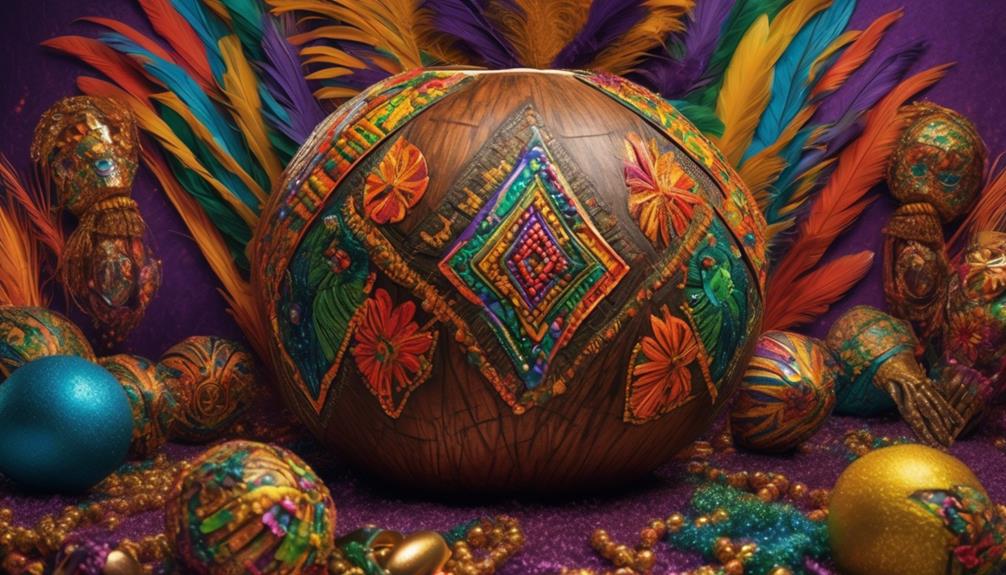
The future of the Zulu Coconut tradition holds great promise as it continues to evolve and enrich the cultural heritage of Mardi Gras. The impact of this tradition on the community is undeniable, and its future impact is equally significant. Community involvement has been a driving force in shaping the future of the Zulu Coconut tradition.
As the tradition continues to evolve, there's a growing emphasis on community engagement and participation. This not only ensures the preservation of the tradition but also fosters a sense of unity and belonging within the community.
Looking ahead, the future of the Zulu Coconut tradition will likely see an even greater emphasis on community involvement. This could involve initiatives to educate and involve younger generations in the tradition, ensuring its continuity for years to come. Additionally, there may be an increased effort to use the tradition as a platform for charitable and community-driven endeavors, further solidifying its role as a unifying force within the community.
The future of the Zulu Coconut tradition is bright, and its continued evolution will undoubtedly leave a lasting and positive impact on the Mardi Gras community.
Frequently Asked Questions
How Can I Participate in the Zulu Coconut Tradition at Mardi Gras?
We're excited to share some tips on participating in the Zulu coconut tradition at Mardi Gras.
When it comes to coconut etiquette, it's important to remember that catching a coconut is a special honor. During the Zulu parade, be ready to show your excitement and appreciation.
As for decorative coconut ideas, consider vibrant colors and Mardi Gras themes. These coconuts make fantastic souvenirs and are cherished by many.
Are There Any Specific Rules or Guidelines for Catching Coconuts at Mardi Gras?
When catching coconuts at Mardi Gras, there are specific rules and guidelines to follow. It's important to pay attention to the parade and be ready to catch the coconuts when they're thrown.
The traditions and cultural significance of catching coconuts are woven into the fabric of Mardi Gras, making it an exciting and cherished experience. Understanding the rules adds to the excitement and ensures everyone can enjoy this unique tradition.
What Are Some Creative Ways to Display and Showcase Zulu Coconuts After Collecting Them?
When it comes to showcasing Zulu coconuts after collecting them, there are so many creative display ideas to choose from! We can transform them into a unique centerpiece for our Mardi Gras celebration, create a shadow box display, or even turn them into a stunning piece of wall art.
The collecting tradition of these coconuts makes them a cherished part of the celebration, and finding creative ways to showcase them adds an extra layer of excitement to the festivities.
Are There Any Specific Techniques or Strategies for Increasing My Chances of Catching a Coconut at Mardi Gras?
When it comes to increasing our chances of catching a coconut at Mardi Gras, we've found that positioning ourselves strategically along the parade route is key.
We like to scope out spots near the front of the crowd, where we can make eye contact with the float riders and show off our best dance moves.
It's all about creating a connection and standing out in the sea of revelers.
Will the Zulu Coconut Tradition Continue to Evolve in the Future, and if So, How?
In the future, the Zulu coconut tradition will likely continue to evolve, reflecting the community's changing values and artistic expression. This evolution will further enhance the cultural significance of the tradition and its impact on the community.
As the tradition adapts to modern times, it will maintain its unique charm and historical relevance while embracing new forms of artistic and cultural expression, ensuring that it remains a cherished aspect of Mardi Gras for generations to come.
Conclusion
As we eagerly await the next Mardi Gras, we can't help but think of the valuable Zulu coconuts and the joy they bring.
Like hidden treasures waiting to be discovered, these coconuts symbolize the excitement and anticipation of the festival.
Just as we eagerly search for these prized throws, we eagerly await the next Mardi Gras season, full of fun, tradition, and the chance to catch our own piece of Zulu coconut magic.
- About the Author
- Latest Posts
Introducing Ron, the home decor aficionado at ByRetreat, whose passion for creating beautiful and inviting spaces is at the heart of his work. With his deep knowledge of home decor and his innate sense of style, Ron brings a wealth of expertise and a keen eye for detail to the ByRetreat team.
Ron’s love for home decor goes beyond aesthetics; he understands that our surroundings play a significant role in our overall well-being and productivity. With this in mind, Ron is dedicated to transforming remote workspaces into havens of comfort, functionality, and beauty.
Mardi Gras Decoration
What Is the Most Popular Drink in New Orleans?
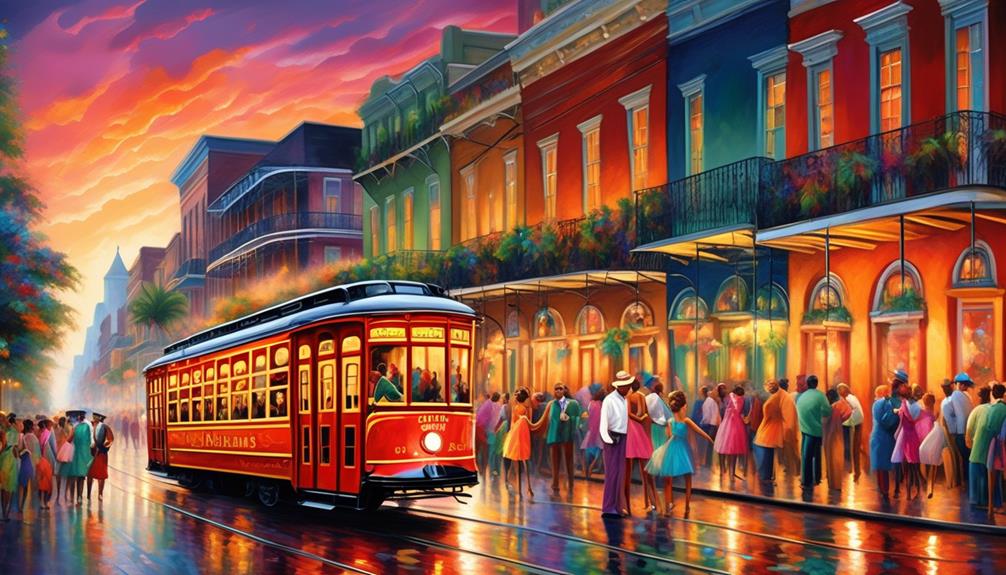
What is the most popular drink in New Orleans, a city known for its rich culinary traditions and vibrant cultural heritage, which holds symbolic significance for both locals and visitors alike?
As we explore the historical origins, cultural significance, traditional ingredients, and serving customs, we uncover a tapestry of flavors and stories that make this question an intriguing one to ponder.
Join us as we embark on a journey to unravel the secrets behind New Orleans' most beloved libation.
Key Takeaways
- The most popular drink in New Orleans has historical origins dating back to the 19th century and is intrinsically linked to cultural celebrations like Mardi Gras and Jazz Fest.
- The traditional recipe for the most popular drink includes absinthe, sugar, Peychaud's Bitters, and rye whiskey, with each ingredient playing a crucial role in creating a complex and aromatic flavor profile.
- The drink is traditionally served in chilled glasses and can be garnished with twists of lemon, dashes of bitters, or innovative garnishes in contemporary variations. Unique serving vessels like hollowed-out pineapples, mason jars, and iconic glassware add to the visual appeal and authenticity of the drinking experience.
- Famous variations of the drink include the Hurricane cocktail, Sazerac cocktail, and Mint Julep cocktail, and notable establishments in New Orleans like Lafitte's Blacksmith Shop and the Sazerac Bar have made lasting contributions to the city's cocktail culture.
Historical Origins
With roots dating back to the 19th century, the historical origins of the most popular drink in New Orleans can be traced to the convergence of various cultural influences in the city's vibrant and dynamic past.
The historical evolution of this iconic beverage reflects the cultural impact of the diverse communities that have shaped New Orleans. From the French and Spanish colonial periods to the contributions of African, Caribbean, and Native American traditions, the regional adaptations of this drink have been integral to its traditional evolution.
During the early 1800s, the influx of immigrants and the international trade in New Orleans led to the introduction of different spirits and flavors, which greatly influenced the local drinking culture. The blending of techniques and ingredients from these varied sources gave rise to the distinctive character of the city's signature drink.
This historical journey not only reveals the drink's deep ties to New Orleans' multicultural heritage but also underscores its significance as a symbol of unity and celebration in the city's social fabric.
Cultural Significance

The historical origins of the most popular drink in New Orleans reveal the deep cultural significance of this iconic beverage, reflecting the diverse communities and traditions that have shaped the city's rich heritage.
Cultural celebrations in New Orleans, such as Mardi Gras and Jazz Fest, are intrinsically linked to the consumption of this beloved drink. Its presence is a testament to the city's cultural traditions, with its roots intertwining with various ethnic influences that have melded together over time.
From its association with jazz music to its role in traditional Southern cuisine, this drink has become an inseparable part of the cultural fabric of New Orleans. The act of sipping this beverage transcends mere refreshment; it symbolizes community, conviviality, and the preservation of longstanding cultural customs.
As we delve into the depths of New Orleans' cultural tapestry, we find this drink woven into the very essence of the city's identity, embodying the resilience and vibrancy of its diverse cultural heritage.
Traditional Ingredients
Entwined within the historical tapestry of New Orleans, the traditional ingredients of the city's most popular drink carry a legacy of cultural fusion and culinary artistry. The traditional recipe for this iconic beverage includes absinthe, sugar, Peychaud's Bitters, and rye whiskey, all of which combine to create a complex and aromatic flavor profile. Each ingredient plays a crucial role, with absinthe contributing its anise-flavored nuances, the sugar providing a touch of sweetness, Peychaud's Bitters imparting a unique floral and herbal essence, and the rye whiskey adding depth and warmth to the concoction.
However, as with any enduring tradition, modern interpretations have also emerged. While the core ingredients remain steadfast, contemporary variations may introduce subtle deviations, such as the use of different types of bitters, alternative sweeteners, or innovative garnishes. These modern twists honor the heritage of the original recipe while offering a fresh perspective that resonates with evolving palates.
The enduring appeal of this esteemed libation lies not only in its storied past but also in its adaptability to contemporary tastes, ensuring its place as a beloved icon of New Orleans' rich culinary landscape.
Preparation Methods
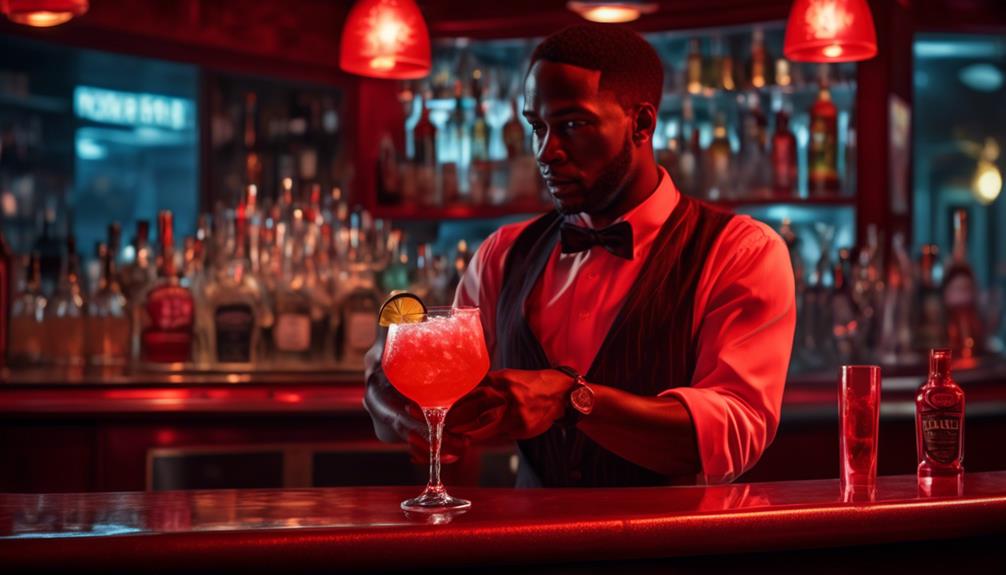
Incorporating a precise sequence of steps and meticulous attention to detail, the preparation of New Orleans' most popular drink requires a skilled hand and a deep appreciation for the historical significance of each ingredient. The crafting of this iconic beverage involves a careful balance of flavors and a nod to its cultural roots.
Here are the essential aspects of preparing this beloved drink:
- Mixing Techniques: The preparation involves a unique mixing technique that requires expertise and finesse. From the vigorous shaking of ingredients to the precise layering of flavors, every step is crucial in achieving the perfect balance of taste and texture.
- Flavor Profiles: The drink boasts complex flavor profiles that are achieved through a thoughtful combination of ingredients. From the sweetness of certain elements to the subtle bitterness of others, each flavor must harmonize seamlessly to create the signature taste that has captivated locals and visitors alike.
- Regional Variations and Historical Influences: The preparation methods may vary across different establishments, each with its own historical influences and regional adaptations. Understanding the historical context and regional nuances is imperative in mastering the art of preparing this renowned beverage.
The meticulous preparation methods and historical influences contribute to the enduring appeal and cultural significance of New Orleans' most popular drink.
Serving Customs
We can't talk about serving customs in New Orleans without mentioning the unique tradition of being able to drink on the streets. The city's iconic cocktail recipes, such as the Sazerac and the Hurricane, are often served in distinct vessels that add to the overall experience.
Understanding the historical and cultural significance of these serving customs can provide valuable insight into the rich tapestry of New Orleans' drinking culture.
Drinking on Streets
One can't overlook the unique serving customs that have long been intertwined with the tradition of drinking on the streets in New Orleans. The outdoor drinking culture in this vibrant city is steeped in history and tradition, creating a lively and convivial atmosphere that sets it apart from many other places.
When it comes to public consumption of beverages, particularly alcoholic ones, New Orleans has established some fascinating customs over the years. These include:
- To-go cups: It's a common sight to see people strolling the streets with their favorite libation in hand, thanks to the city's lax open container laws.
- Iconic drinks: Classic cocktails like the Sazerac and the Hurricane are often enjoyed on the go, adding to the city's distinct street drinking culture.
- Festive occasions: Street parties and festivals provide ample opportunities for outdoor imbibing, further enhancing the city's reputation for embracing public drinking.
Iconic Cocktail Recipes
What fascinating historical customs and traditions have shaped the serving customs of iconic cocktail recipes in New Orleans?
New Orleans' cocktail history is a rich tapestry woven with influences from European, Caribbean, and American cultures. The city's mixology techniques have been shaped by the fusion of French, Spanish, and African heritage, leading to the creation of iconic cocktails like the Sazerac, Ramos Gin Fizz, and the Hurricane.
These recipes have endured the test of time, each with its own unique serving customs that reflect the city's vibrant and diverse past. The meticulous preparation of these drinks, often involving specific glassware, garnishes, and mixing methods, pays homage to the cocktail culture deeply rooted in New Orleans.
Every sip is a journey through the city's history, a testament to the artistry and craftsmanship of its renowned mixologists.
Unique Serving Vessels
The history of New Orleans' iconic cocktails is intricately intertwined with the unique serving vessels that reflect the city's diverse cultural heritage and cocktail culture. These vessels aren't just containers; they're part of the experience, enhancing the enjoyment of the drink.
Here are some remarkable examples:
- Novel Presentation: Cocktails served in hollowed-out pineapples or coconuts, adding a tropical flair to the drinking experience.
- Unconventional Containers: Drinks served in mason jars, copper mugs, or even mini fishbowls, offering a playful and unconventional twist on traditional glassware.
- Historical Glassware: Some bars and restaurants in New Orleans still serve cocktails in vintage glassware, adding a touch of nostalgia and authenticity to the drinking experience.
These unique serving vessels not only elevate the visual appeal of the cocktails but also contribute to the distinct charm of New Orleans' cocktail culture.
Iconic Vessels
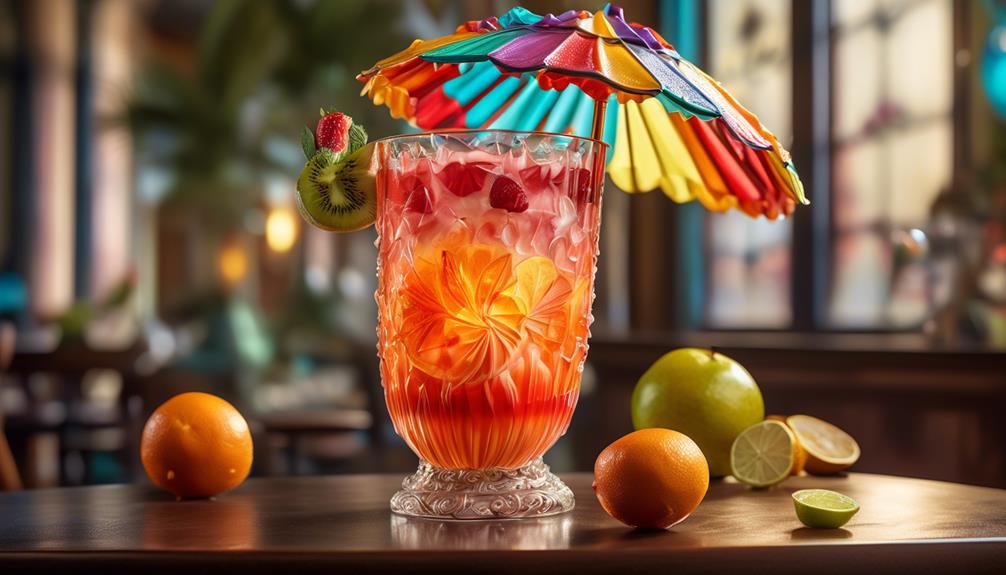
Sailors and merchants of the 18th century frequented New Orleans, bringing with them a diverse array of vessels that would eventually become iconic symbols of the city's drinking culture. These vessels have undergone a remarkable historical evolution, evolving from practical containers to decorative designs that capture the essence of New Orleans' vibrant spirit. The iconic vessels used in New Orleans' drinking establishments often reflect the city's rich history and diverse cultural influences.
| Vessel | Description |
|---|---|
| Hurricane Glass | This tall, curvy glass represents the enduring spirit of New Orleans. Originally designed to withstand hurricane-force winds, it is now synonymous with the city's famous cocktail, the Hurricane. |
| Sazerac Glass | This elegant, stemmed glass is steeped in history, specifically designed for the iconic Sazerac cocktail, which originated in New Orleans. Its delicate design reflects the refinement of the city's cocktail culture. |
| Hand Grenade Cup | Shaped like a hand grenade, this unique vessel is associated with the potent Hand Grenade cocktail, a beloved fixture on the streets of the French Quarter. Its playful design captures the lively, carefree nature of New Orleans. |
These vessels not only serve as containers for drinks but also as tangible connections to the city's rich history, adding an extra layer of authenticity and charm to the drinking experience in New Orleans.
Famous Variations

Iconic vessels have played a significant role in shaping New Orleans' drinking culture. Exploring the famous variations of drinks served in these vessels offers a deeper understanding of the city's rich history and diverse cultural influences.
Here are three famous variations of drinks served in iconic vessels in New Orleans:
- Hurricane: This famous variation is a sweet and tangy cocktail made with dark rum, passion fruit syrup, and fresh lemon juice. It's typically served in a tall, curvy glass that resembles a hurricane lamp, which gives the drink its name. Pat O'Brien's Bar, a historic establishment in the French Quarter, is renowned for popularizing this iconic drink during the 1940s.
- Sazerac: Considered one of the oldest cocktails in the United States, the Sazerac is a potent blend of rye whiskey, sugar, Peychaud's Bitters, and a dash of absinthe. It's traditionally served in an Old Fashioned glass, often accompanied by a lemon twist. The Sazerac is closely tied to the history of New Orleans and is a beloved variation enjoyed by locals and visitors alike.
- Mint Julep: While traditionally associated with the Kentucky Derby, the Mint Julep also holds a place in New Orleans' drinking culture. This famous variation consists of bourbon, fresh mint, sugar, and water, and is usually served in a silver or pewter cup filled with crushed ice. The Mint Julep is a refreshing and iconic drink that has been enjoyed in New Orleans for centuries.
Popular Occasions
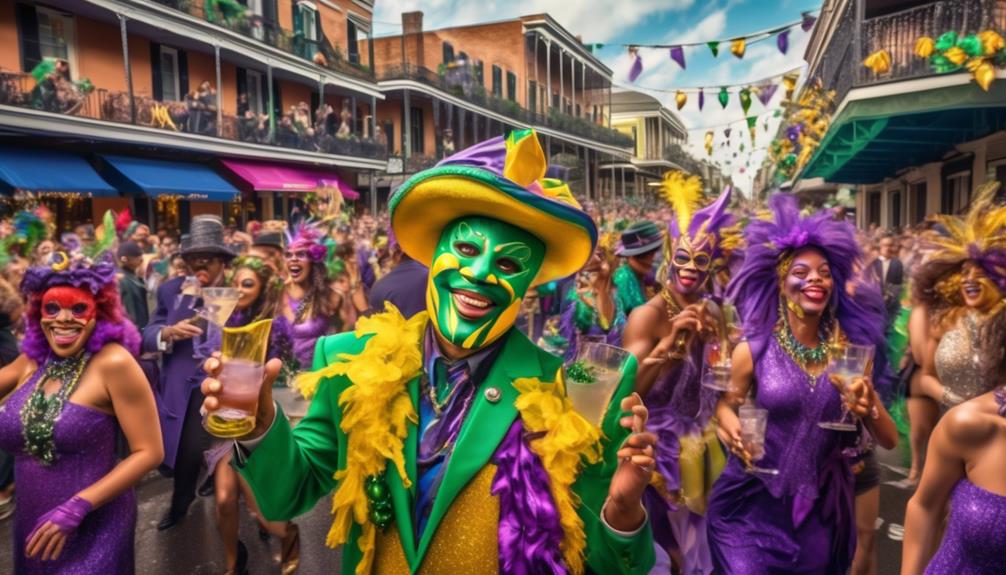
During festive gatherings and cultural celebrations, New Orleans locals and visitors alike partake in the city's iconic beverages, embracing the rich historical ties and vibrant drinking culture that define these popular occasions. In New Orleans, special occasions and iconic events are often marked by the consumption of traditional drinks, reflecting the city's unique drinking culture and local preferences. From Mardi Gras parades to jazz festivals, these events offer a perfect opportunity to savor classic New Orleans cocktails while immersing oneself in the city's lively atmosphere.
| Special Occasions | Iconic Events |
|---|---|
| Mardi Gras | Jazz Festivals |
| Southern Weddings | French Quarter Fests |
| New Year's Eve | Saints Game Days |
At Mardi Gras, revelers are often seen enjoying the vibrant hues of the famous Hurricane cocktail, while jazz festivals provide a platform for showcasing the city's love for the Sazerac. Southern weddings are incomplete without a toast of the timeless Southern Comfort, and New Year's Eve celebrations call for a glass of bubbly or the local favorite, the Vieux Carré. Saints game days in New Orleans are also marked by the enjoyment of cold beers and refreshing mint juleps. These occasions not only highlight the city's drinking culture but also serve as a testament to the historical significance of these iconic beverages in New Orleans.
Notable Establishments
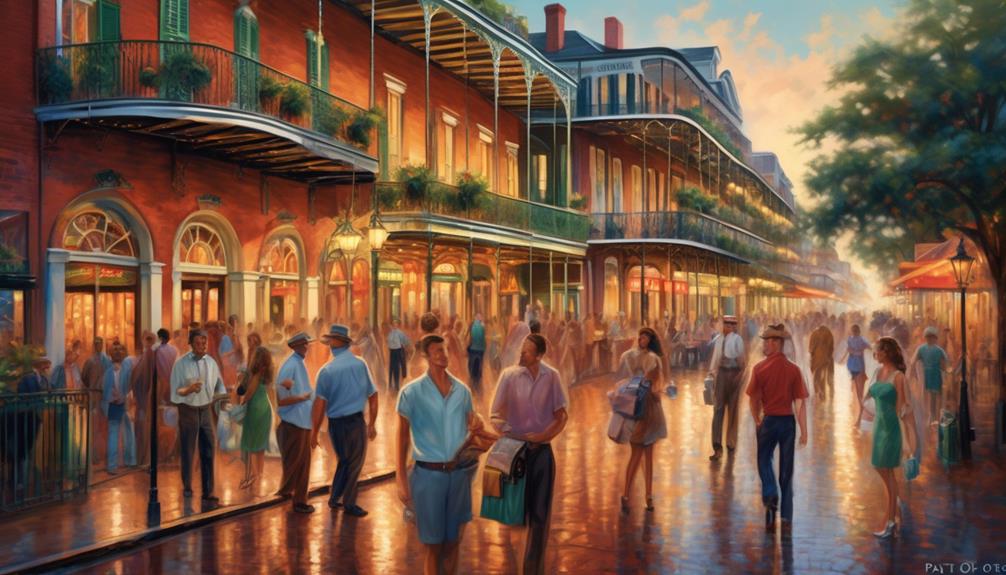
What notable establishments have played a significant role in shaping New Orleans' drinking culture and historical significance?
New Orleans is home to iconic landmarks that have left an indelible mark on beverage history and mixology techniques. Here are three notable establishments that have contributed to the city's rich drinking culture:
- Lafitte's Blacksmith Shop: Established in the 18th century, this historic bar is reputed to be the oldest structure used as a bar in the United States. Known for its dimly lit ambiance and strong ties to pirate lore, it has become a symbol of New Orleans' enduring allure.
- Arnaud's French 75 Bar: Located in the heart of the French Quarter, this elegant bar is renowned for its classic cocktails and timeless charm. It has been a fixture in New Orleans' cocktail scene since the 1940s, offering a glimpse into the city's sophisticated side.
- Sazerac Bar at The Roosevelt Hotel: This legendary bar is famed for being the birthplace of the Sazerac cocktail, a quintessential New Orleans libation. Steeped in history and luxury, it has been a cornerstone of the city's cocktail renaissance, attracting locals and visitors alike.
These establishments haven't only stood the test of time but have also shaped the very essence of New Orleans' drinking culture, making them integral to the city's historical significance.
Local Favorites

Local favorites among the diverse drinking establishments in New Orleans reflect the city's vibrant and ever-evolving beverage culture, encompassing a range of traditional and innovative libations.
One of the most beloved local favorites is the Sazerac, a timeless cocktail that originated in the city in the 19th century. Made with rye whiskey, absinthe, Peychaud's Bitters, and a sugar cube, the Sazerac embodies the rich history and flavor of New Orleans.
Another cherished favorite is the classic Hurricane, a sweet and tangy concoction of rum, fruit juices, and syrup that has been a staple in the city since the 1940s.
What sets these local favorites apart are the local ingredients and traditional recipes used by the skilled mixologists. For instance, many establishments take pride in using locally distilled spirits and fresh fruit juices sourced from nearby farms.
The commitment to honoring traditional recipes while also embracing innovative techniques has solidified these drinks as staples of New Orleans' beverage culture.
Whether it's the historic Sazerac or the tropical flair of the Hurricane, these local favorites continue to captivate both locals and visitors with their timeless appeal and distinct flavors.
Global Influence

New Orleans' global influence on the beverage culture is evident in the diverse array of international flavors and techniques incorporated into its traditional drinks. The city's cultural evolution has been shaped by various global influences, which have significantly impacted its renowned cocktail scene.
This influence can be seen in the following ways:
- French Influence: The French Quarter, with its charming bistros and cafes, has infused New Orleans with a rich tradition of wine and brandy, contributing to the city's sophisticated approach to drink mixing.
- Caribbean Influence: The Caribbean's rum-making techniques have permeated the city's cocktail culture, giving rise to iconic drinks like the Hurricane, which embodies the tropical and flavorful essence of the region.
- Spanish Influence: The Spanish heritage in New Orleans has left an indelible mark on the city's beverage culture, with the introduction of ingredients like sherry and the implementation of unique aging processes.
New Orleans' global influence and cultural evolution haven't only diversified its traditional drinks but have also fostered an environment where innovation and experimentation continue to thrive, making it a global epicenter of mixology.
Controversies and Debates
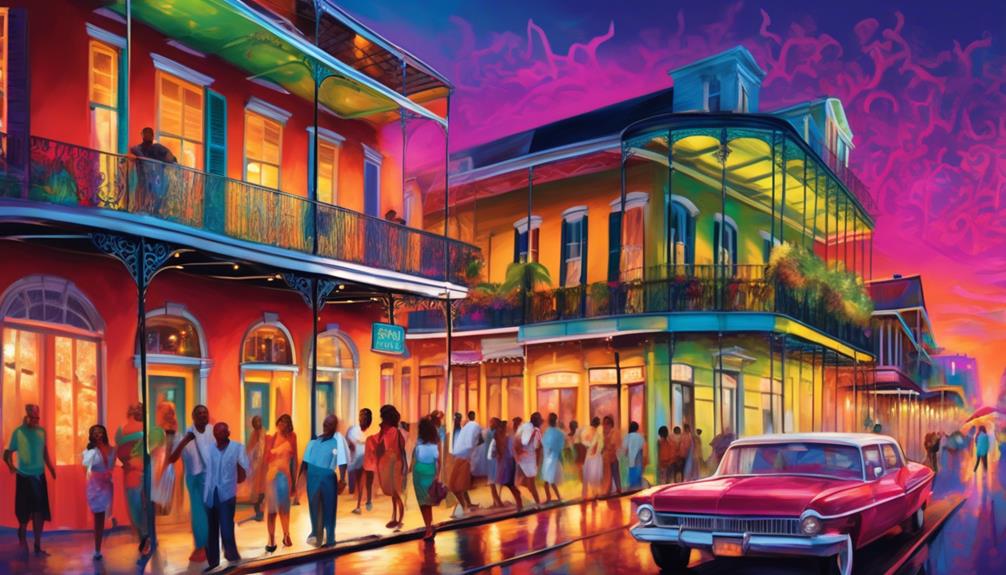
When examining the historical origins and cultural significance of the most popular drink in New Orleans, controversies and debates often arise. The drink's connection to various cultures and the evolution of its recipe over time have sparked discussions about its true roots.
Additionally, debates about the proper way to prepare and serve the drink have been ongoing, adding layers of complexity to its status as a beloved New Orleans tradition.
Historical Origins
Amidst the rich tapestry of New Orleans' history, the origins of the city's most popular drink are shrouded in controversy and debate, making it a subject of historical intrigue and speculation. The historical evolution of this iconic beverage reflects the cultural evolution of the city itself, blending indigenous roots with colonial influences.
Indigenous Roots: The drink's origins can be traced back to the indigenous people of the region who used local ingredients to create early versions of the beverage.
Colonial Influences: The arrival of European settlers brought new distillation techniques and the introduction of specific ingredients, shaping the drink into a form closer to what's known today.
Historical Evolution: Over time, the drink has evolved, influenced by diverse cultural groups, resulting in the creation of unique variations and traditions that have become synonymous with New Orleans' identity.
Cultural Significance
Pivoting from the historical origins of the city's most popular drink, the cultural significance of this iconic beverage is rife with controversies and debates, revealing the intricate layers of its evolution and impact on New Orleans' identity.
The drink has woven itself into the cultural traditions and social rituals of the city, becoming emblematic of New Orleans' vibrant and diverse heritage.
However, debates surrounding cultural appropriation and commercialization have surfaced, questioning the authenticity of the drink's representation. Some argue that its commercial popularity has led to a dilution of its original cultural significance, while others view its widespread adoption as a celebration of New Orleans' rich history.
These controversies reflect the complex interplay between tradition and modernity, shedding light on the evolving nature of cultural practices within the city.
Evolving Trends
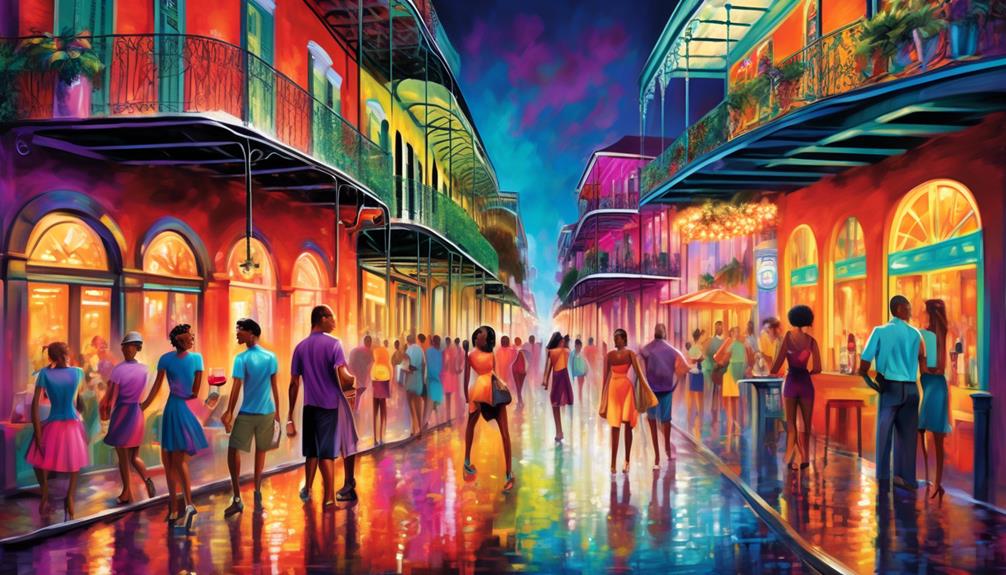
In recent years, the consumption of craft cocktails has been steadily increasing in New Orleans, reflecting an evolving trend in the city's drinking culture. This surge in popularity can be attributed to several factors:
- Flavor Exploration: There's a growing interest in flavor exploration among New Orleans' drinkers. Craft cocktails offer a wide range of unique and complex flavors, enticing enthusiasts to experiment with new taste profiles and ingredients. This trend has led to a greater appreciation for the art of mixology and has elevated the expectations of what constitutes a great drink.
- Mixology Techniques: The resurgence of mixology techniques has played a pivotal role in shaping the drinking landscape of the city. Bartenders are increasingly focusing on the craftsmanship of cocktail-making, employing innovative methods such as house-made bitters, infused syrups, and creative garnishes. This attention to detail has elevated the quality of drinks and heightened the overall drinking experience.
- Cultural Shift: There's a noticeable cultural shift towards valuing quality over quantity in the drinking scene. Consumers are seeking out well-crafted, artisanal cocktails that showcase the skill and creativity of the bartender, marking a departure from the previous emphasis on mass-produced, standard drinks.
The evolving trend towards craft cocktails underscores a deeper appreciation for the art and science of mixology, fostering a more sophisticated and discerning drinking culture in New Orleans.
Future Innovations
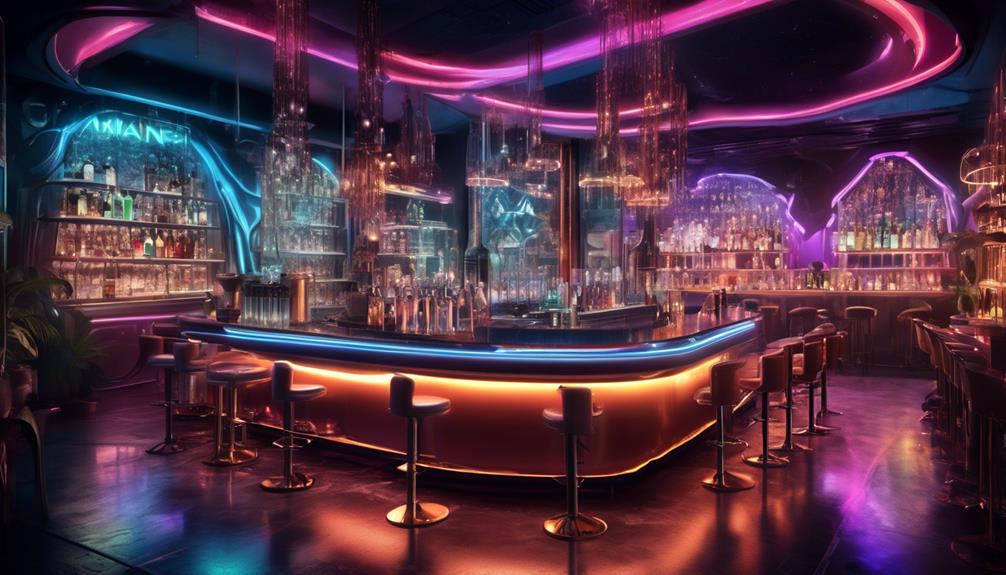
We anticipate that drink trends in New Orleans will continue to evolve, with a focus on flavor experimentation and innovative beverage pairings.
As the city's culinary scene thrives, mixologists and bartenders are likely to push boundaries and create new, exciting drinks that reflect the unique flavors and culture of New Orleans.
With a rich history of mixology and a growing interest in craft cocktails, we foresee an era of unprecedented creativity and innovation in the city's drinking culture.
Drink Trends
Amidst the rich history and tradition of New Orleans' beverage culture, there's a palpable anticipation for the future innovations that will continue to shape the drink trends in this vibrant city.
Mixology trends and cocktail culture are evolving in New Orleans, with an increasing focus on artisanal ingredients and creative presentations. Bartenders are experimenting with unique flavor combinations and innovative techniques to push the boundaries of traditional cocktail making.
Local favorites are gaining global influence as New Orleans' iconic drinks, such as the Sazerac and Ramos Gin Fizz, are being celebrated worldwide, leading to a resurgence of classic recipes and a renewed interest in the city's cocktail heritage.
The blending of diverse cultural influences, from Creole and Cajun to French and Spanish, continues to inspire new and exciting drink creations that reflect the city's dynamic culinary landscape.
Flavor Experimentation
As New Orleans' beverage culture continues to evolve and embrace new mixology trends, the exploration of flavor experimentation stands at the forefront of future innovations in the city's drink scene.
Mixologists in New Orleans are delving into a realm of creative and daring combinations, pushing the boundaries of traditional flavors to create unique and exciting experiences for locals and visitors alike.
This city's rich history and diverse cultural influences provide a fertile ground for mixology techniques that draw inspiration from a wide range of culinary traditions. From infusing classic cocktails with local ingredients like chicory or satsuma to experimenting with bold spice blends, the flavor experimentation in New Orleans reflects the city's vibrant and dynamic spirit.
These innovative approaches aren't only redefining the local beverage landscape but also paying homage to the city's culinary heritage.
Beverage Pairing
Future innovations in beverage pairing will revolutionize the way we experience the complementary relationship between drinks and food, elevating the dining and imbibing experience to new heights. Mixology techniques and the art of food pairings will converge to create a symphony of flavors that dance on the palate.
Here are the key aspects of this exciting development:
- Customization: Advanced mixology will enable personalized beverage pairings tailored to individual tastes and dietary preferences.
- Culinary Collaborations: Renowned chefs and mixologists will collaborate to curate seamless pairings, enhancing the nuances of both the dish and the drink.
- Scientific Precision: Utilizing scientific principles, such as molecular gastronomy, to understand the chemical interactions between food and drinks, resulting in innovative and unexpected pairings.
These innovations will redefine the way we savor culinary delights, fostering a deeper appreciation for the art of food and drink.
Frequently Asked Questions
What Are the Health Benefits or Drawbacks of the Most Popular Drink in New Orleans?
Health benefits and drawbacks of the most popular drink in New Orleans depend on the specific beverage. The cultural significance of this drink is undeniable, as it's deeply woven into the city's history and traditions.
From a health perspective, some of these drinks may contain high sugar content, while others, like the famous Sazerac, may offer the potential benefits of moderate alcohol consumption.
Are There Any Superstitions or Rituals Associated With the Consumption of the Popular Drink in New Orleans?
Superstitions and traditions surround the consumption of the popular drink in New Orleans. Many locals believe that certain rituals, like stirring the drink clockwise, bring good luck. The cultural significance of these practices runs deep, woven into the fabric of New Orleans' history.
It's fascinating how such superstitions and consumption rituals have endured, offering a glimpse into the city's rich heritage. These customs contribute to the unique allure of New Orleans.
How Has the Popularity of the Drink in New Orleans Affected the Local Economy and Tourism Industry?
The popularity of the drink in New Orleans has significantly impacted local businesses, turning it into a major tourist attraction and revenue generator.
The drink's notoriety has led to a surge in tourism, as visitors flock to the city to indulge in its unique and historical drinking culture.
This has provided a substantial boost to the local economy, with bars, restaurants, and distilleries benefiting from the influx of enthusiastic patrons.
Are There Any Unique Ways That the Popular Drink in New Orleans Is Being Incorporated Into Modern Cuisine or Mixology?
Incorporating the popular drink in New Orleans into modern mixology and culinary fusion has led to some truly inventive creations. Mixologists and chefs are blending traditional flavors with contemporary techniques, resulting in unique and delicious offerings.
This trend not only pays homage to the city's rich culinary history but also showcases its ability to adapt and innovate. It's exciting to see how the iconic drink continues to inspire new and creative interpretations.
What Environmental or Sustainability Considerations Are Being Taken Into Account With the Production and Consumption of the Popular Drink in New Orleans?
When it comes to the environmental impact and sustainable production of the popular drink in New Orleans, we're seeing a growing emphasis on eco-friendly practices.
From sourcing local ingredients to reducing packaging waste, the industry is making strides towards sustainability.
Additionally, efforts to support fair trade and ethical labor practices are becoming integral to the production process.
This commitment to environmental and social responsibility enhances both the drink and the overall experience.
Conclusion
In conclusion, the Sazerac has stood the test of time as the most popular drink in New Orleans, weaving its way through history and culture with its unique blend of flavors and traditions.
Like a river flowing through the heart of the city, the Sazerac has carved its place in the soul of New Orleans, leaving an indelible mark on the local and global cocktail scene.
Its legacy continues to inspire and captivate, ensuring its enduring presence for generations to come.
Cheers to the Sazerac!
- About the Author
- Latest Posts
Introducing Ron, the home decor aficionado at ByRetreat, whose passion for creating beautiful and inviting spaces is at the heart of his work. With his deep knowledge of home decor and his innate sense of style, Ron brings a wealth of expertise and a keen eye for detail to the ByRetreat team.
Ron’s love for home decor goes beyond aesthetics; he understands that our surroundings play a significant role in our overall well-being and productivity. With this in mind, Ron is dedicated to transforming remote workspaces into havens of comfort, functionality, and beauty.
-

 Vetted4 weeks ago
Vetted4 weeks ago15 Best Contact Paper for Kitchen Cabinets to Elevate Your Home Decor
-

 Vetted2 weeks ago
Vetted2 weeks ago15 Best Poe Cameras for Home Security – Reviews & Buying Guide
-

 Vetted4 weeks ago
Vetted4 weeks ago15 Best Drain Snakes to Unclog Your Pipes Like a Pro
-

 Beginners Guides1 week ago
Beginners Guides1 week agoI Inhaled Vinegar Fumes
-

 Vetted4 weeks ago
Vetted4 weeks ago14 Best Stationery Brands for Your Next Writing Adventure
-

 Beginners Guides3 weeks ago
Beginners Guides3 weeks agoSwinger Porch Light Color
-

 Mardi Gras Decoration4 weeks ago
Mardi Gras Decoration4 weeks agoWhy Does Hobby Lobby Not Do Mardi Gras?
-

 Vetted2 weeks ago
Vetted2 weeks ago15 Best Blinds for Bathroom Windows to Enhance Privacy and Style























